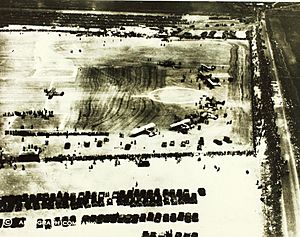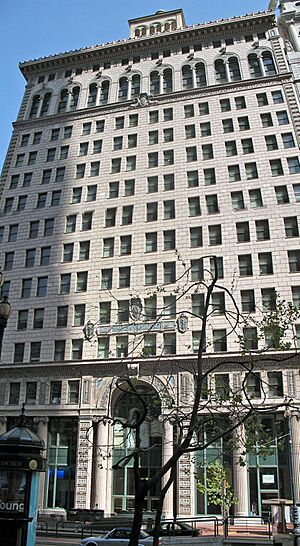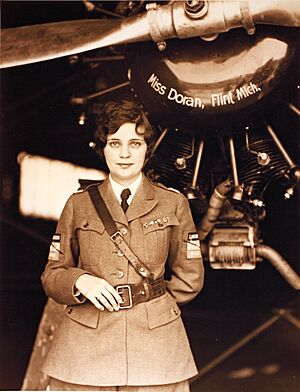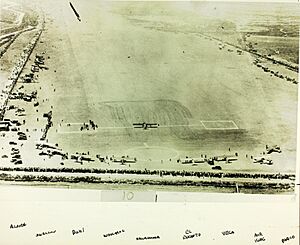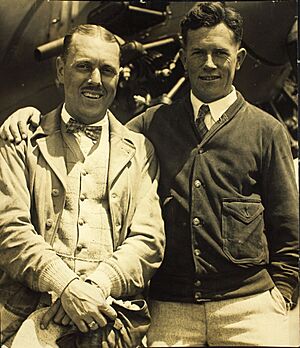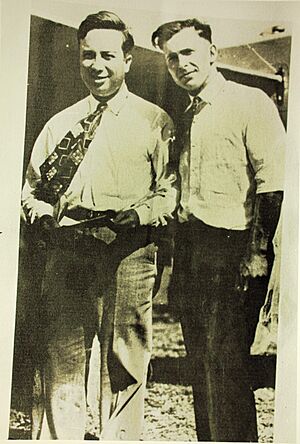Dole Air Race facts for kids
| Category | Air Racing |
|---|---|
| Country | United States |
| Inaugural season | 1927 |
| Teams | 8 |
| Drivers' champion |
|
| Teams' champion | Woolaroc (sponsored by Phillips Petroleum Company) |
The Dole Air Race, also known as the Dole Derby, was a very challenging air race across the Pacific Ocean. It took place in August 1927. Pilots flew from Oakland, California to Honolulu in Hawaii. Many planes entered, but only eight actually started the race. Out of those eight, only two successfully reached Hawaii.
The winning plane, Woolaroc, was flown by Arthur C. Goebel and William V. Davis. They finished the flight in 26 hours and 15 minutes. The second-place plane, Aloha, arrived two hours later. Sadly, this race was very dangerous. Before, during, and after the race, ten people lost their lives. Six airplanes were also lost or badly damaged.
Contents
The Dole Air Race: A Daring Flight
The Big Prize for Pacific Flight
In 1927, Charles Lindbergh made history by flying across the Atlantic Ocean. This inspired James D. Dole, a pineapple businessman from Hawaii. On May 25, 1927, Dole announced a huge prize. He offered $25,000 for the first plane to fly from Oakland, California, to Honolulu, Hawaii. This was a distance of about 3,870 kilometers (2,405 miles). He also offered $10,000 for second place. The flights had to happen within 12 months after August 15, 1927. Dole hoped Lindbergh himself would join the race.
Other rich business people also offered prizes for Pacific flights. They wanted to set new long-distance flight records. The rules for the Dole race were created by the National Aeronautic Association in Honolulu.
Early Pacific Flights Before the Race
Before the Dole race officially started in August 1927, two other flights already crossed the Pacific. On June 28, U.S. Army Air Corps Lieutenants Lester J. Maitland and Albert F. Hegenberger flew a military plane from Oakland to Oahu. They completed the flight in 25 hours and 50 minutes.

Another civilian plane, the City of Oakland, also tried to fly to Hawaii. It was flown by Ernie Smith and Captain C.H. Carter. They had mechanical problems and had to turn back. Later, Smith tried again with a new navigator, Emory Bronte. On July 14, they ran out of fuel and crash-landed in a thorn tree on Molokai.
Dole said these earlier flights didn't count for his prize. This was because they didn't follow his specific rules. For example, the Army flight had been planned long before Dole announced his prize.
Getting Ready to Fly
The first official pilot to enter the race was Arthur C. Goebel. Many pilots who entered were known for daring stunts. They were part of a group called the "Thirteen Flying Black Cats." This group was known for exciting Hollywood stunt flying.
On August 8, 1927, the pilots drew numbers for their starting positions. This happened in San Francisco. Pilots could choose to take off from either Mills Field or Oakland International Airport. But later, everyone decided to take off from Oakland. This was because the air currents at Mills Field were too risky.
Problems Before Takeoff
Before the race, many planes had mechanical issues during test flights. For example, the Pabco Flyer broke a fuel line. The Golden Eagle damaged its landing gear and propeller. The Oklahoma had engine problems and was forced to land twice.
The Miss Doran also had engine trouble. The pilot, Auggy Pedlar, and passenger, Mildred Doran, had to land in a wheat field. They damaged the landing gear and had to find tools to fix it.
Pilots had to show their planes and licenses by August 8. This was to make sure they were ready and safe. Officials worried that many planes might not have enough fuel capacity to make the long flight. Rules said single-engine planes needed to carry 460 gallons of fuel.
Delays and Tough Tests
The race was supposed to start on August 12, but it was delayed. This was due to many mechanical problems, failed tests, and bad weather. The government's Aeronautics Division felt the race was too unsafe. They suggested a two-week delay or even changing the route. However, the race organizers decided to go ahead.
Navigators had to pass a tough three-part test. It included a written test, an oral test, and a flying test. By August 12, only four crews had passed these tests. The deadline to qualify was extended to August 15.
Some planes withdrew or were disqualified. The City of Peoria was disqualified less than an hour before the race started. This was because its fuel tanks were too small for the long journey.
Three Crashes, Three Lives Lost
Just before the race, three planes crashed in three days.
- On August 10, the Spirit of John Rodgers crashed into a cliff near San Diego. Both men on board, George W. D. Covell and R. S. Waggener, died.
- On August 11, the Pride of Los Angeles crashed into San Francisco Bay while approaching Oakland. The three men on board survived by swimming to shore.
- On August 12, the Angel of Los Angeles crashed during a test flight. The pilot, Arthur V. Rogers, died.
These accidents showed how risky the race was.
The Race Begins
The Dole Air Race finally began on August 16, 1927. A huge crowd of 75,000 to 100,000 people came to watch. The weather was foggy, but the planes were cleared for takeoff just before noon.
Takeoff Troubles
The first takeoffs were difficult because the planes were very heavy with fuel.
- The Oklahoma took off first, but soon returned with an overheating engine.
- The El Encanto crashed right after takeoff, damaging its wing.
- The Pabco Flyer also crashed shortly after lifting off.
Luckily, the crews of these planes were not hurt.
The last five planes successfully departed. The Golden Eagle, Miss Doran, Aloha, Woolaroc, and Dallas Spirit all got into the air. However, Miss Doran and Dallas Spirit soon turned back due to engine problems. Miss Doran tried a second takeoff and succeeded. Pabco Flyer also tried again but crashed a second time, putting it out of the race for good.
In the end, only four planes were flying towards Hawaii: Golden Eagle, Aloha, Woolaroc, and Miss Doran. To help the pilots, several ships were placed along the route. These ships sent out radio signals to guide the planes and were ready to help in an emergency.
Who Won?
Woolaroc Arrives First
Woolaroc, flown by Arthur Goebel and navigated by William Davis, flew high above the clouds. Davis used special tools like sextants and smoke bombs to find their way. They also used radio signals from the ships, but mainly relied on their own instruments. Woolaroc was the only plane with a two-way radio, so they could send and receive messages.
They radioed Hawaii when they were about 200 miles away. A large crowd of 25,000 to 30,000 people greeted them in Hawaii. Goebel and Davis won the race in 26 hours and 17 minutes. They earned the $25,000 first prize.
Aloha Takes Second Place
Martin Jensen, flying Aloha, arrived about two hours after Woolaroc. His flight took 28 hours and 16 minutes. Jensen often flew very low, just 10 to 50 feet above the ocean. This saved fuel but made it hard to navigate by the stars. His navigator, Paul Schluter, had to use the sun to figure out their position.
When Aloha landed, it had only 5 gallons of fuel left! Jensen and Schluter won the $10,000 second prize. However, Jensen gave Schluter only $25 of the winnings. This caused some talk, as Schluter had done amazing navigation using only basic methods.
The Search for Missing Planes
Sadly, the Golden Eagle and Miss Doran were never seen again after they took off. James Dole offered a $10,000 reward for anyone who found either plane. The planes' sponsors also matched this reward.
The Golden Eagle had a radio that could receive signals, but Miss Doran had no radio at all. Both planes were supposed to carry water, food, and a life raft. But these supplies were limited. The ocean was also very rough.
Pilots Jensen and Goebel helped search the ocean on August 18. The U.S. Navy also launched a massive search. 42 Navy ships, including an aircraft carrier, searched for the missing planes. Three submarines also joined the search.
The Last Flight of Dallas Spirit
The Dallas Spirit, which had returned to Oakland for repairs, decided to join the search. Pilot William Erwin and navigator Alvin Eichwaldt took off on August 19. They had a powerful radio on board.
Their last radio message, received at 9 PM that night, said they were in a tailspin about 600 miles out at sea. The Dallas Spirit was also never seen again. A Navy ship rushed to the last known location but found no trace of the plane.
The Navy's search was huge, covering an area of 350,000 square miles. It involved 54 ships and many airplanes. Despite all this effort, no wreckage or clues were found for the three missing planes.
Small Clues and Hoaxes
Over the next few months, some small pieces of debris were found. Yellow debris was spotted off the coast of Washington, thought to be from Golden Eagle. A silver piece of an airplane part washed ashore in California, possibly from Dallas Spirit.
A piece of a life jacket was found near a beach in Hawaii. Some people also reported finding notes in bottles, supposedly from the missing flyers. However, these notes were later believed to be hoaxes. The reward for finding the planes was finally removed in March 1928.
Searches continued for a long time. In May 1928, Martin Jensen flew over Hawaii's mountains, looking for the Golden Eagle. In April 1929, wreckage of an unknown plane washed ashore. In June 1929, more wreckage was found, including a piece that matched the paint of Miss Doran. But no definite answers were ever found.
What Happened Next?
After the race, Goebel and Davis returned to San Francisco as heroes. They were awarded the Distinguished Flying Cross for their winning flight. They believed that no one could have survived crashing into the sea.
Martin Jensen also returned and planned another daring flight. He wanted to fly nonstop from Los Angeles to New York, carrying a lion! He took off with the lion, named Leo, but crash-landed in Arizona due to heavy fog.
The winning plane, Woolaroc, still exists today. It is on display at the Woolaroc Museum in Oklahoma. The Aloha was later destroyed in a fire in 1933. Both planes used the same type of engine, the Wright Whirlwind. This engine became famous for its reliability in many record-breaking flights.
Many people, including pilots and experts, criticized the Dole Air Race after it ended. They said it was too dangerous for land planes to fly over such a large ocean. They believed such flights had little scientific value. Goebel, Davis, and Jensen all suggested that planes flying over oceans should be required to carry radio equipment.
Despite the tragedies, the Dole Air Race showed that flying across the Pacific was possible. Less than a year later, in 1928, Charles Kingsford Smith successfully flew from Oakland to Australia, stopping in Hawaii. Later, in 1935, Amelia Earhart made the first solo flight from Hawaii to California. Soon after, regular commercial flights began crossing the Pacific, making air travel much safer and more common.
Race Summary
 Notes:
|
|||||||||||
| Aircraft | Start | Pilot | Navigator | Livery | Finish | Notes | Ref. | ||||
|---|---|---|---|---|---|---|---|---|---|---|---|
| Make & Model | Name | Reg. | Image | Draw | Launch | ||||||
| Travel Air 5000 | Oklahoma | NX911 |  |
1 | 1 | Bennett Griffin | Al Henley | Blue with yellow wings | DNS | Had to return after 30 minutes because of fuselage problems. | |
| Goddard Special | El Encanto | NX5074 |  |
2 | 2 | Norman A. Goddard | Kenneth C. Hawkins | Silver | DNS | Crashed during takeoff. | |
| Breese-Wilde Model 5 | Pabco Pacific Flyer | NX646 | 7 | 3 | Livingston Gilson Irving | Orange and black | DNS | Crashed after two attempts to take off. | |||
| Lockheed Vega | Golden Eagle | NX913 |  |
15 | 4 | Jack Frost | Gordon Scott | Gold with blue landing gear. | DNF | Lost at sea. | |
| Buhl Airsedan | Miss Doran | NX2915 | 4 | 5 | Auggie Pedlar | Lt. V. R. Knope | Red wings, white fuselage, blue tail | DNF | Passenger was Mildred Doran. Returned once due to engine trouble, then took off again. Lost at sea. | ||
| Breese-Wilde Model 5 | Aloha | NX914 |  |
11 | 6 | Martin Jensen | Paul Schluter | Lemon yellow with pink lei | 2 | ||
| Travel Air 5000 | Woolaroc | NX869 |  |
9 | 7 | Arthur Goebel | William J. Davis | Yellow and blue | 1 | Finished with very little fuel left. | |
| Swallow Monoplane | Dallas Spirit | NX941 |  |
5 | 8 | William Portwood Erwin | Alvin Eichwaldt | Green | DNS | Had to return with engine trouble. Lost at sea while searching for other missing planes. | |
| Entrants that withdrew, crashed, or disqualified prior to race start | |||||||||||
| Aircraft | Start | Pilot | Navigator | Livery | Finish | Notes | Ref. | ||||
| Make & Model | Name | Reg. | Image | Draw | Launch | ||||||
| Air King biplane | City of Peoria | NX3070 | 3 | — | Charles Parkhurst | Ralph Lowes | Silver | DQ | Disqualified for not having enough fuel capacity. | ||
| Hess Bluebird | Wanda | NX1445 | 6 | — | Frederick A. Giles | DQ | Could not meet the qualification deadline. | ||||
| International CF-10 | Pride of Los Angeles |  |
8 | — | James L. Giffin | Theodore S. Lundgren | X | Crashed into San Francisco Bay on August 11. Both survived. | |||
| — | — | — | 10 | — | Robert C. Fowler | WD | Withdrew because he couldn't get a plane. | ||||
| International F-17W biplane | Miss Hollydale | NX912 |  |
12 | — | Frank L. Clarke | Jeff Warren | WD | Withdrew from the race on August 13. | ||
| Tremaine Hummingbird | Spirit of John Rodgers |  |
13 | — | George D. Covell | Richard S. Waggener | X | Crashed on August 10 while flying to the race start. No survivors. | |||
| Bryant Monoplane | Angel of Los Angeles | NX705 |  |
14 | — | Arthur V. Rogers | X | Crashed during a test flight on August 12. No survivors. | |||
Images for kids
-
Pride of Los Angeles in San Francisco Bay [crashed Aug 11; three survived]


